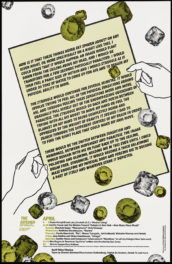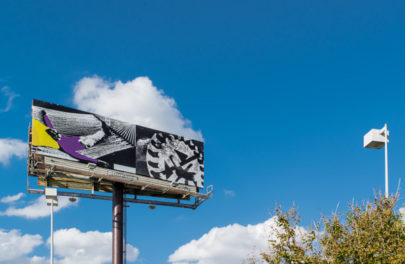For more than five decades, Donald Blumberg has often turned to the mass media for inspiration for his work. During the war in Vietnam, for example, he exploited both television and his local newspaper to critique the war.
Blumberg reframed nightly news images into mosaic collages that ask viewers to question what they’re looking at; from the local newspaper, he lifted stories and memorialized those lost with a thick, black frame. More recently, Blumberg has photographed television screens with closed captioning and news scrolls to comment upon the meaning of mass media images.
A selection of his Vietnam War period work is included in an exhibition at the Getty Museum, Breaking News: Turning the Lens on Mass Media (December 20, 2016–April 30, 2017).
I interviewed Donald Blumberg for the exhibition’s audio tour (two tracks are embedded below, and the full tour is available free online) and have had the pleasure of speaking to him about his more recent work after the exhibition opened. This post is the product of our ongoing conversations about his work.
Laura Hubber: Mass media was so different during the Vietnam War. Could you speak a little bit about the relationship between war and television in the 1960s?
Donald Blumberg: Well, first of all, the televisions were black and white. There was no cable, and the images that were coming across were on very small screens.
1968 was a very volatile year, and I decided to use the television as a source of material. It was a constant stream of very significant news events, and the main characters were [Lyndon B.] Johnson, Nixon, George Wallace and Martin Luther King.
The first thing I did was screw around with the dials so that I could create different patterns that were inherent to television image transmission itself.

I made an image of 16 empty screens of white noise that was like an introduction to the concept of mosaic. Instead of having a single image that told the story, there is a sequence of images.
I think of these as reportage, but not a single image like Cartier-Bresson’s photographs of people eating lunch on the banks of the Seine or W. Eugene Smith’s images of a country doctor, but a nouveau reportage.
LH: Why did you use the mosaic technique?
DB: The mosaic concept comes from travel. My wife and I traveled to Italy a lot. In Ravenna there are several cathedrals, and they have the most beautiful Byzantine mosaics you could imagine.
The concept of the mosaic pictures is taking disparate parts and fusing them into a single image, which can be read in multiple ways.
LH: Were these images meant to be political acts?
DB: They were direct political acts. These were supposed to be brutal propaganda photographs. That’s what I intended them to be.
I was teaching in Buffalo at the time. The university was closed. The police had billeted the campus. There were no classes.
A group of police came by with clubs, chasing students who were demonstrating on campus. The students were clubbed in the stairwell and arrested for criminal trespass.
That, to me, was a very disturbing experience and it kind of changed my attitude about what a photographer should be doing. I felt it was no longer appropriate to make aesthetically pleasing decorative art that would add to the history of photography. I concluded the only thing to do would be to make photographs that would have some contribution to the anti-war movement. So, that was the turning point that led to this whole group of photographs you see in the exhibition.
I had reached the point where I decided that I was not interested in making photographs anymore unless they were political. So this whole period from ’68 through ’72 were all specifically designed to be political images.
LH: What message do you hope that these images would convey to the viewer?
DB: People have limited memory. The images were made to fix the period. To fix the trauma that the troops were experiencing and to fix the trauma that people were experiencing at home. The images were intended to have a life over time.
LH: How did the Daily News photographs come about?
DB: We would get the Buffalo Evening News every day and the stuff in the newspaper was horrific. I mean, it was just unbelievable. You couldn’t believe that every time you opened up the paper there would be a picture of two young 18 or 19-year-old Buffalo kids who were friends and got killed in Vietnam.
So, I started clipping the articles, and they were quite small, 3 x 4 inches, and I put them in a box. I collected them. I decided to re-photograph them and the idea was to make large images, 20 x 24 inch images that were inescapable to the viewer. They were intended to be a record of what was going on during that period of time. My intent was the same as with the television mosaics: to fix the transient.
There was an enormous pathos about the Vietnam War. I mean people were really upset. Everybody who went to Vietnam was taken by the universal military draft. They were literally taken out of their lives and dragged there. These pictures were intended to somehow capture that distress that people were feeling.

Untitled, from the series Daily Photographs, 1969–70, 1969–1970, Donald Blumberg. Gelatin silver print. The J. Paul Getty Museum, gift in honor of the artist. © Donald Blumberg
LH: In this series, you create black frames around the images.
DB: When you use a 35-millimeter negative, in addition to the picture itself there is a black space. The black frame line goes around the entire image. I usually print the black frame in all my photographs because when they are overmatted it’s eliminated and you come directly into the picture. But when I was printing them, the black frame had a symbolic funereal quality: these were dead people, maimed people, and this was a memorial to them based on that frame.
LH: This was also a very early use of appropriating other people’s images.
DB: There’s post-modernist appropriation, which, from the critics’ point of view, is an art form unto itself. I didn’t appropriate the images for the act of appropriating. I appropriated the images because they were functional in conveying the message I wanted to convey with the photographs.
I wanted to make my work political without metaphor, simile, sentimentality or heroics.
LH: After the Vietnam photographs, you went back to making non-political work, including landscapes from your travels around the world. But then, in 2012, you returned to political commentary in your Newtown series. How did that come about?

Untitled, from the series Newtown School Massacre, 2012, 2012, Donald Blumberg. Gelatin silver print. Courtesy of Donald R. and Grace Blumberg. © Donald Blumberg
DB: The Newtown massacre at Sandy Hook Elementary School is part of this series called In Their Own Words, but the real title I had for them was Nouveau Reportage.
LH: This began as a series of photographs of the television that featured closed captions: soap operas, shopping channels and ultimate fighting.
DB: The stuff that preceded the Newtown pictures was playful: the homoerotic nature of wrestling and the ridiculous purchase of expensive houses. Concepts of excess. That whole series has to do with excess, acquiring things and changing body shape.
While l was doing that, the Newtown massacre happened.

Untitled, from the series Newtown School Massacre, 2012, 2012, Donald Blumberg. Gelatin silver print. Courtesy of Donald R. and Grace Blumberg. © Donald Blumberg
The images capture the TV, in which a simultaneous presentation of words, images, and outside voices project into the screen. You don’t see Wolf Blitzer when he says, “I never saw the President so upset.”
To me that’s a very photographic scene because the function of the photographic frame is always to include and exclude information or let information come in through the edges, and Wolf’s voice and the other voices of the commentators that worked themselves literally into the pictures with typography was, to me, an extraordinary extension of the photographic concept.
LH: These images seem far from your Daily Photographs series, but they seem related.
DB: The idea was that those who were victimized by events should be remembered. In both cases, that was the driving force. To memorialize the victim.
The photographs are intended for people not to forget.





Comments on this post are now closed.